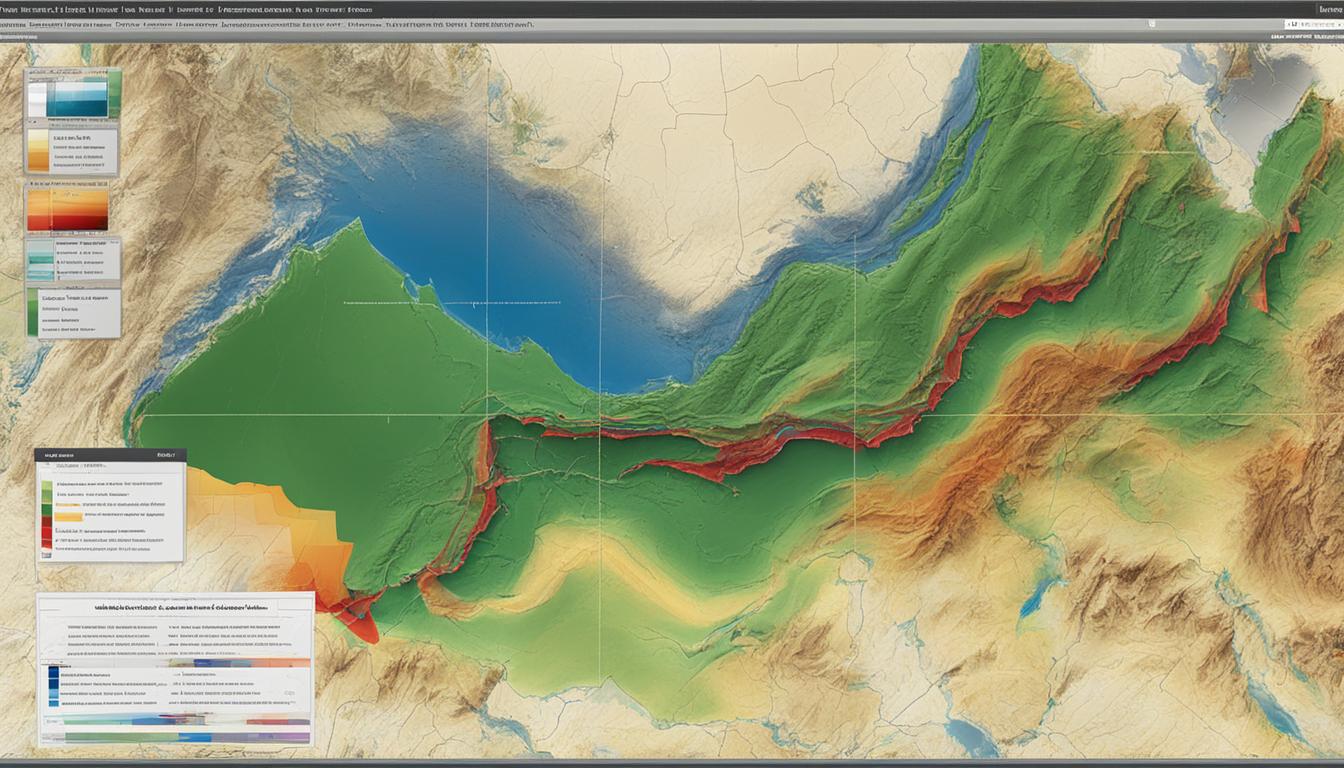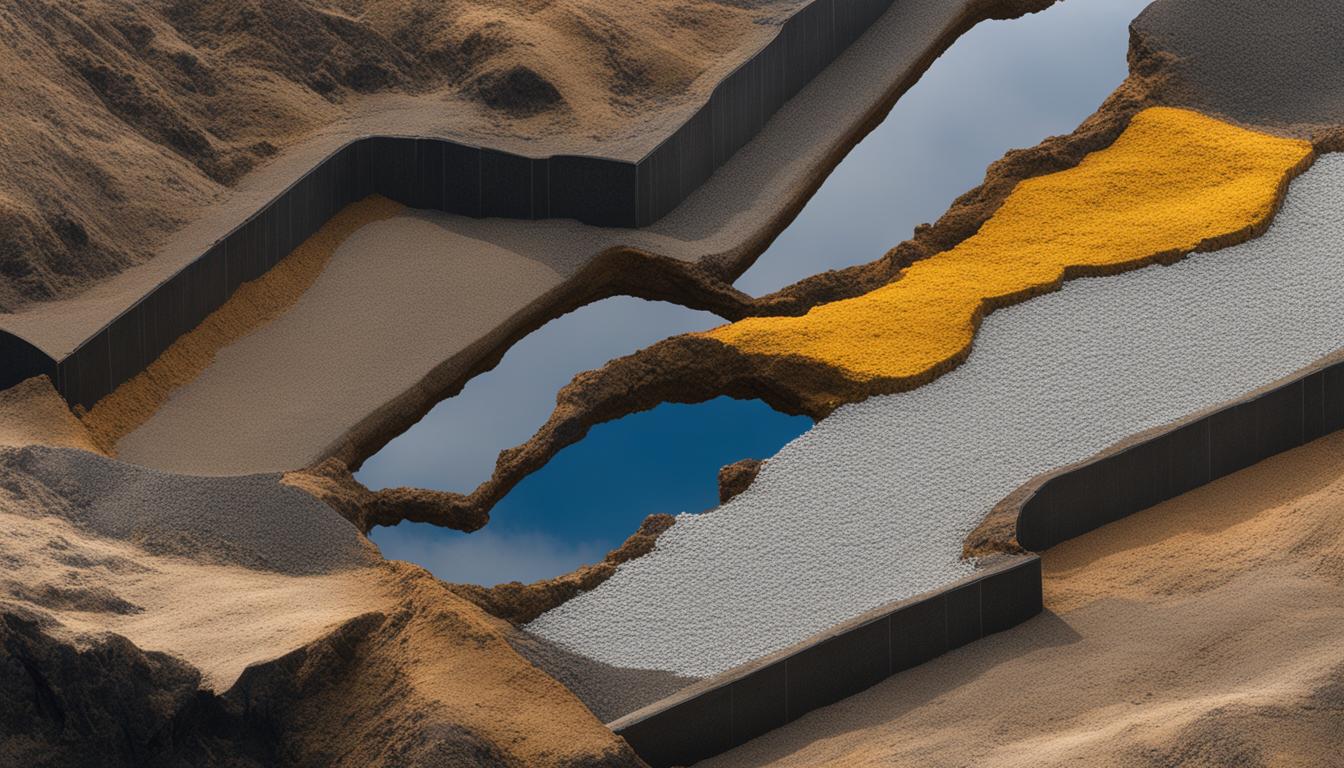Welcome to our article on the difference between earthquake fault types. In this comprehensive guide, we will explore the various types of faults that occur during seismic activity. Understanding these fault types is crucial in comprehending the mechanics and impacts of earthquakes. So let’s dive in and gain a deeper understanding of earthquake fault types.
Key Takeaways:
- Earthquake fault types are classified based on their movement and angle.
- The main types of faults include normal faults, reverse faults, and strike-slip faults.
- Normal faults occur due to extension, while reverse faults result from compression.
- Strike-slip faults involve horizontal movement along the fault plane.
- Faults provide the pathway for the release of accumulated stress, resulting in seismic activity.
Normal Fault
A normal fault is a type of dip-slip fault where the block above the fault moves downward relative to the block below. These faults occur in response to extension, or the pulling apart of rocks, leading to the stretching and thinning of the Earth’s crust. Normal faults are often observed in regions with significant tectonic activity, such as the Western United States Basin and Range Province and along oceanic ridge systems.
Normal faults play a crucial role in the geological processes that shape our planet. They contribute to the formation of mountain ranges, the creation of valleys, and the overall deformation of the Earth’s crust. By studying normal faults, scientists gain valuable insights into the forces that shape our planet’s surface, as well as the mechanisms behind earthquakes.
“Normal faults occur in response to extension and are often observed in the Western United States Basin and Range Province and along oceanic ridge systems.”
Understanding the behavior and characteristics of normal faults is of utmost importance in earthquake hazard assessment. Areas with active normal faults are more prone to experiencing earthquakes, as the block above the fault can suddenly slip, releasing accumulated stress and generating seismic waves. By studying these faults, scientists can better predict and mitigate the impacts of earthquakes in regions where normal faulting is prevalent.
| Characteristics | Examples |
|---|---|
| Dip-slip fault | Western United States Basin and Range Province |
| Associated with extension | Oceanic ridge systems |
Reverse (Thrust) Fault
A reverse (thrust) fault is a type of dip-slip fault where the upper block, located above the fault plane, moves up and over the lower block. It occurs in areas of compression, such as subduction zones where one tectonic plate is being forced underneath another. Japan is known for its active reverse faults due to its subduction location.
When the dip angle of a reverse fault is shallow, it is often referred to as a thrust fault. Thrust faults are responsible for some of the world’s largest and most destructive earthquakes. The 2011 Tohoku earthquake in Japan, which triggered a devastating tsunami, was caused by a thrust fault associated with the subduction of the Pacific Plate beneath the Eurasian Plate.

| Fault Type | Motion | Location Example |
|---|---|---|
| Reverse (Thrust) Fault | Upper block moves up and over the lower block | Japan (Subduction Zones) |
Understanding the mechanics of reverse faults is crucial in assessing earthquake hazards in areas prone to compression. The movement along these faults can cause significant ground displacement and trigger large-magnitude earthquakes. By studying the characteristics of reverse faults and their associated seismic activity, scientists and engineers can better prepare for potential earthquakes and mitigate the impact on vulnerable communities.
Strike-Slip Fault
A strike-slip fault is a type of fault where the two blocks of rock slide past each other horizontally. One notable example of a strike-slip fault is the San Andreas Fault in California, which is famous for its role in the tectonic activity of the region. The San Andreas Fault is known as a right-lateral fault, where the block on the far side of the fault moves to the right when viewed from either side. In contrast, a left-lateral fault would have the displacement of the far block to the left when viewed from either side.
Types of Strike-Slip Faults
Strike-slip faults can be classified as either right-lateral or left-lateral, depending on the direction of horizontal movement along the fault plane. Right-lateral strike-slip faults, like the San Andreas Fault, have a rightward displacement of the far block. Left-lateral strike-slip faults, on the other hand, have a leftward displacement of the far block. These fault types are characterized by their horizontal movement and play a significant role in shaping the Earth’s crust.
Strike-slip faults primarily exhibit horizontal movement.
Understanding the characteristics and behavior of strike-slip faults is crucial for studying tectonic activity and assessing seismic hazards. The movement along these faults can result in earthquakes and the release of accumulated stress in the Earth’s crust. By studying strike-slip faults, scientists can gain insights into the complex dynamics of the Earth’s tectonic plates and the potential risks associated with their movement.
| Type | Direction of Movement |
|---|---|
| Right-Lateral | Rightward |
| Left-Lateral | Leftward |
Types of Faults: Normal, Reverse, and Strike-Slip
Faults are fractures in the Earth’s crust where rocks on either side have moved relative to each other. There are three main types of faults: normal faults, reverse faults, and strike-slip faults. These faults play a significant role in shaping the Earth’s surface and are responsible for the occurrence of earthquakes in different geological settings.
Normal faults occur when the hanging wall, the block of rock above the fault, moves downward relative to the footwall, the block of rock below the fault. They are typically associated with areas undergoing extension, where the Earth’s crust is being pulled apart. One prominent example of normal faults can be seen in the Western United States Basin and Range Province, where the crust has been stretched and faulted.
Reverse faults, also known as thrust faults, are the opposite of normal faults. In this case, the hanging wall moves upward and over the footwall due to compression in the crust. Reverse faults are commonly observed in subduction zones, such as the ones found in Japan, where one tectonic plate is being forced beneath another. When the dip angle of a reverse fault is shallow, it is often referred to as a thrust fault.
Strike-slip faults involve horizontal movement along the fault plane. These faults occur when two blocks of rock slide past each other in a sideways motion. The San Andreas Fault in California is a well-known example of a right-lateral strike-slip fault, where the displacement of the far block is to the right when viewed from either side. Left-lateral strike-slip faults exhibit the opposite displacement. The primary movement along strike-slip faults is horizontal, with little to no vertical displacement.
| Fault Type | Movement | Example |
|---|---|---|
| Normal Fault | Downward movement of hanging wall relative to footwall | Western United States Basin and Range Province |
| Reverse Fault | Upward movement of hanging wall relative to footwall | Japan (subduction zones) |
| Strike-Slip Fault | Horizontal movement along fault plane | San Andreas Fault, California |
Understanding the different types of faults is crucial in studying the mechanics of earthquakes and assessing earthquake hazards in specific regions. Each fault type exhibits distinct movements and is associated with particular geological settings. By analyzing fault types and their characteristics, scientists can gain valuable insights into seismic activity and the potential risks posed by earthquakes.
Relationship between Faults and Earthquakes
Earthquakes occur on different types of faults, and the specific type of fault determines the nature of the earthquake. In general, strike-slip earthquakes occur on strike-slip faults, normal earthquakes occur on normal faults, and thrust earthquakes occur on reverse or thrust faults. The movement of the fault during an earthquake is responsible for the release of accumulated stress, which generates seismic activity.
During an earthquake, the rocks on either side of the fault slip past each other, causing vibrations that propagate as seismic waves. The fault surface can be vertical, horizontal, or at an angle to the surface of the Earth. This movement on the fault is what leads to the shaking and destruction associated with earthquakes.
“The relationship between faults and earthquakes is crucial in understanding the mechanics of seismic activity. Faults serve as pathways for the release of accumulated stress, resulting in the occurrence of earthquakes.”
– Dr. Laura Jackson, Seismologist.
Table: Comparison of Earthquakes on Different Fault Types
| Fault Type | Earthquake Type |
|---|---|
| Strike-slip Fault | Strike-slip Earthquake |
| Normal Fault | Normal Earthquake |
| Reverse or Thrust Fault | Thrust Earthquake |

Table: Common Faults and Associated Earthquake Hazards
| Fault Type | Associated Hazards |
|---|---|
| Normal Fault | Ground shaking, displacement of structures |
| Reverse (Thrust) Fault | Strong ground shaking, potential for landslides |
| Strike-Slip Fault | Ground shaking, potential for rupture along the fault line |
The table above summarizes some common fault types and their associated earthquake hazards. It is important to note that the severity of these hazards can vary depending on factors such as fault size, depth, and proximity to populated areas. Understanding these hazards is vital for implementing effective mitigation strategies and ensuring the safety and resilience of communities in earthquake-prone regions.
Conclusion
In conclusion, understanding the different types of earthquake faults is essential in comprehending the mechanics and impacts of earthquakes. Normal faults occur due to extension, reverse faults result from compression, and strike-slip faults involve horizontal movement. Faults play a significant role in earthquake occurrence and can be identified and mapped using various resources.
By understanding the relationship between faults and earthquakes, individuals can assess earthquake hazards and take appropriate measures for mitigating risks. Quaternary faults, which have moved in the past 1.6 million years, are particularly important in evaluating earthquake hazards. Fault maps, such as the Quaternary Fault and Fold Database, provide valuable information about the location of faults.
For those living in earthquake-prone areas, it is crucial to consider the proximity to faults. Utilizing tools like the “How Close to a Fault Do You Live?” tool in California can help determine the distance from nearby faults. Additionally, earthquake hazard maps from organizations like the Earthquake Hazards Program and Seismic Hazard Maps can further inform individuals about the potential risks associated with fault zones.
FAQ
What is a fault?
A fault is a fracture or zone of fractures between two blocks of rock that allows the blocks to move relative to each other.
What are the different types of faults?
The different types of faults include normal faults, reverse faults, and strike-slip faults.
How do normal faults occur?
Normal faults occur when the hanging wall has moved downward relative to the footwall due to extension.
How do reverse faults occur?
Reverse faults occur when the hanging wall has moved upward relative to the footwall due to compression.
What is a strike-slip fault?
A strike-slip fault is a fault on which the two blocks slide past one another horizontally.
How do faults relate to earthquakes?
Faults provide the pathway for the release of accumulated stress, resulting in seismic activity and earthquakes.
What are quaternary faults?
Quaternary faults are those that have been recognized at the surface and have moved in the past 1.6 million years.
How can I assess earthquake hazards based on faults?
Understanding the proximity of a property or specific location to a fault is important in assessing earthquake hazards. Resources like the “How Close to a Fault Do You Live?” tool in California can help determine the proximity to faults.
 Skip to main content
Skip to main content


